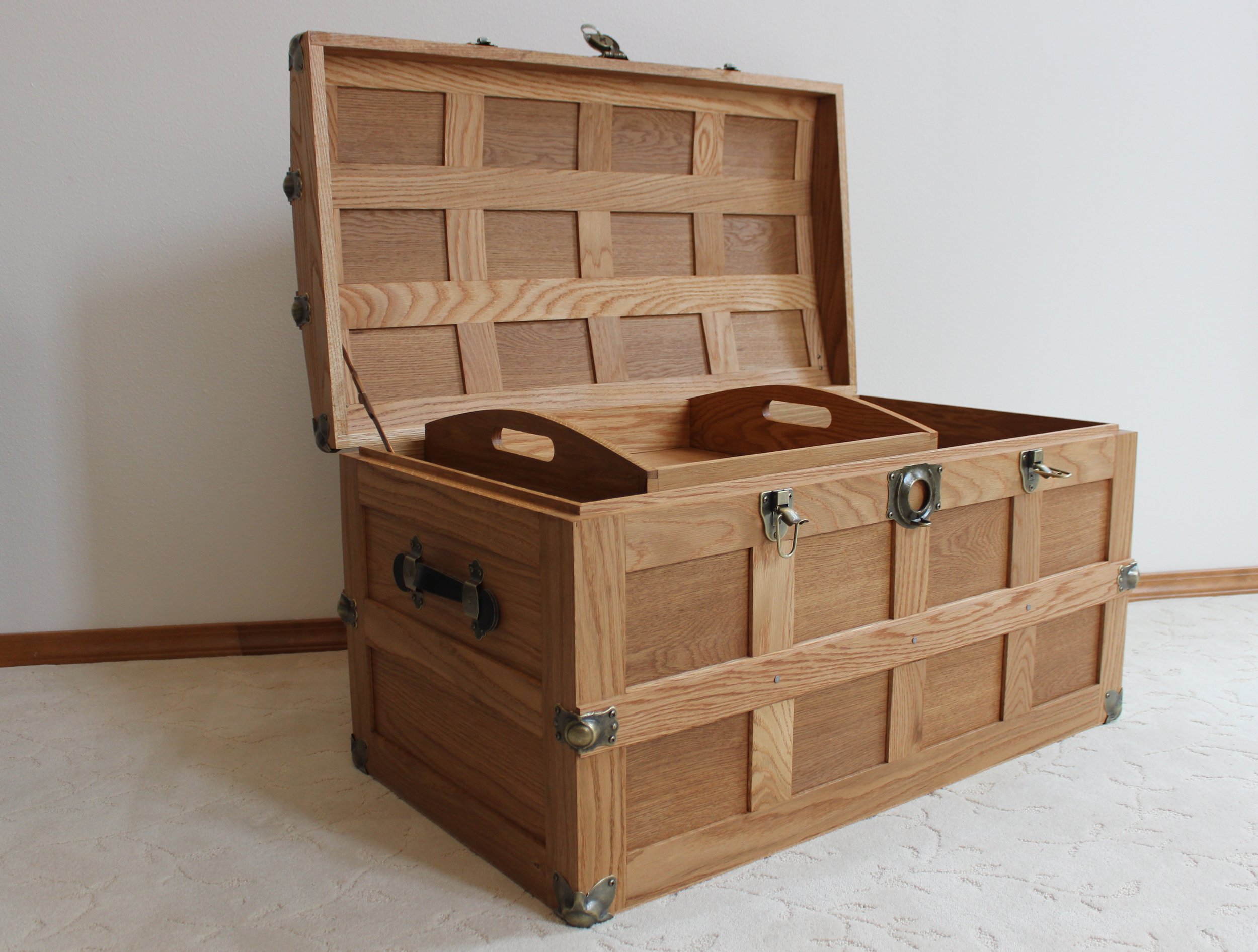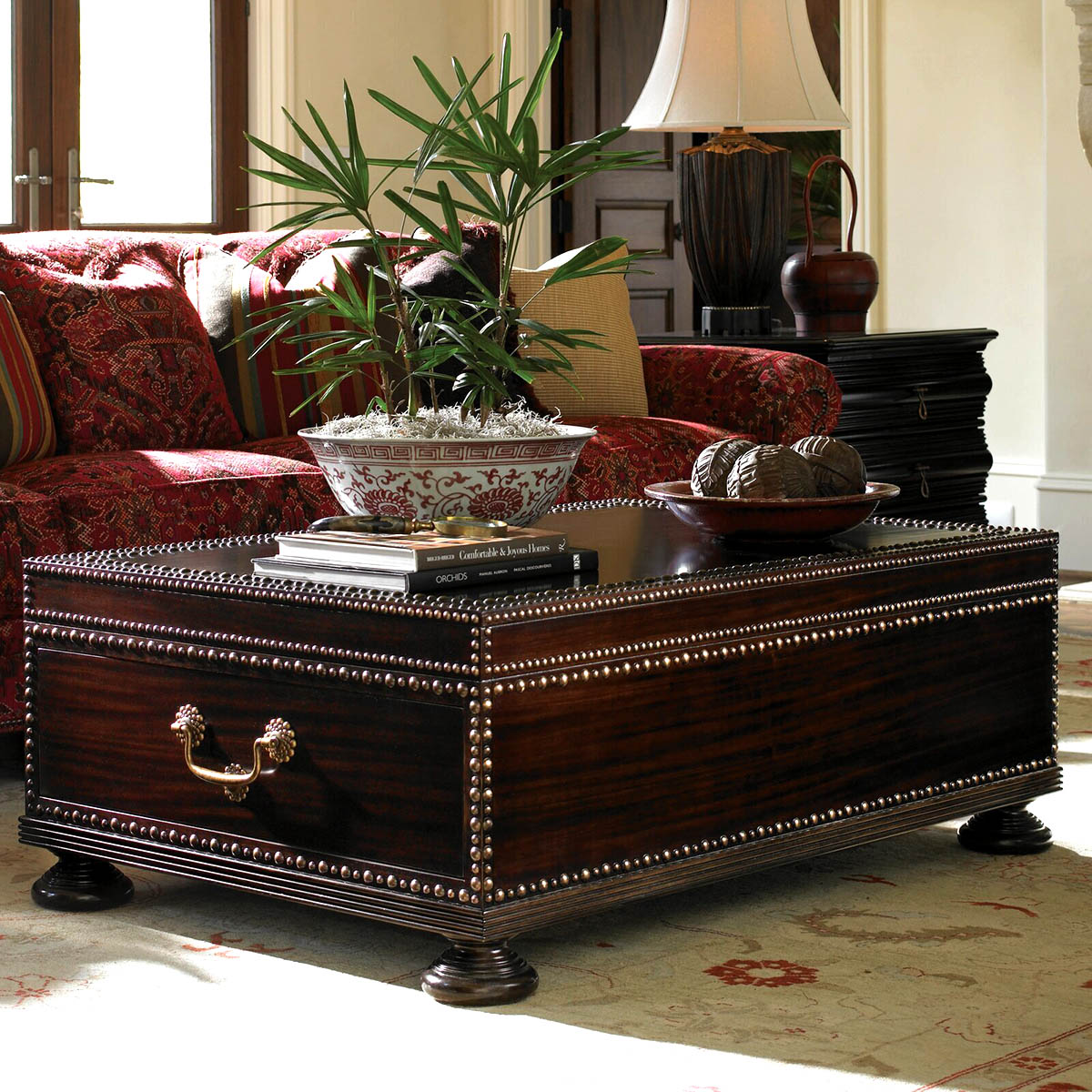

Articles
How To Make A Steamer Trunk
Modified: May 6, 2024
Learn how to make a stunning steamer trunk with our detailed articles. Discover step-by-step instructions and expert tips for a successful project.
(Many of the links in this article redirect to a specific reviewed product. Your purchase of these products through affiliate links helps to generate commission for Storables.com, at no extra cost. Learn more)
How To Make A Steamer Trunk
A steamer trunk is a classic piece of luggage that exudes elegance and brings a touch of nostalgia to any space. Whether you’re a vintage enthusiast or simply looking for a unique storage solution, making your own steamer trunk can be a rewarding and fulfilling project. In this guide, we’ll walk you through the steps of creating your very own steamer trunk that will not only serve as a functional storage piece but also a beautiful heirloom to cherish for years to come.
Key Takeaways:
- Crafting a steamer trunk allows for complete customization, quality control, cost savings, and a valuable learning experience, making it a rewarding DIY project for vintage enthusiasts and woodworking novices alike.
- Building a steamer trunk involves meticulous planning, precise woodworking, and attention to detail, resulting in a functional and visually stunning piece of furniture that can be cherished for generations.
Read more: Where To Buy Steamer Trunks
Materials and Tools
Introduction
Steamer trunks have a rich history and were popular during the 19th and early 20th centuries as travel became more accessible. These large, sturdy trunks were designed to withstand long journeys on steamships and trains, hence the name “steamer trunk”. They were typically made of high-quality materials such as wood and leather, providing durability and protection for the belongings inside.
Making your own steamer trunk allows you to recreate this piece of history and have a unique storage solution that reflects your personal style. Here are a few benefits of making your own steamer trunk:
1. Customization: When you make your own steamer trunk, you have complete control over its design and dimensions. You can choose the specific type of wood, hardware, and finishes that match your aesthetic preferences. This ensures that your steamer trunk fits perfectly into your home decor and meets your storage needs.
2. Quality: While you can find vintage or pre-made steamer trunks, making your own allows you to ensure the quality of the materials used and the craftsmanship involved. You can select high-quality wood and materials that will last for generations. This ensures that your steamer trunk is not only visually appealing but also built to withstand the test of time.
3. Cost savings: While making your own steamer trunk will require an investment in materials and tools, it can be more cost-effective compared to purchasing a high-quality pre-made trunk. Additionally, you’ll have the satisfaction of knowing that you created something with your own hands.
4. Learning experience: Building your own steamer trunk can be a great learning experience, especially if you are new to woodworking or DIY projects. You’ll gain valuable skills and knowledge as you work with different tools, measure and cut wood, and assemble the trunk. This can inspire you to take on more challenging projects in the future.
In the following sections, we’ll guide you through the step-by-step process of making your own steamer trunk, from planning and design to finishing touches. So let’s get started and embark on this exciting DIY journey to create a beautiful and functional steamer trunk.
Key Takeaways:
- Crafting a steamer trunk allows for complete customization, quality control, cost savings, and a valuable learning experience, making it a rewarding DIY project for vintage enthusiasts and woodworking novices alike.
- Building a steamer trunk involves meticulous planning, precise woodworking, and attention to detail, resulting in a functional and visually stunning piece of furniture that can be cherished for generations.
Read more: Where To Buy Steamer Trunks
Materials and Tools
Before you begin making your own steamer trunk, it’s essential to gather all the necessary materials and tools. Here’s a list of what you’ll need:
Materials:
– Wood: Choose a sturdy and visually appealing wood, such as oak, walnut, or mahogany. The amount of wood needed will depend on the dimensions of your trunk.
– Plywood: This will be used for panels and interior compartments.
– Hardware: Purchase hinges, handles, locks, and other decorative hardware to give your trunk a vintage look.
– Trim: Optional, but adding decorative trim can enhance the overall aesthetic of your steamer trunk.
– Wood glue: A strong adhesive to join the wood pieces together.
– Screws and nails: Used to secure the panels and hardware to the trunk.
– Stain or paint: Choose a finish that suits your preference and complements your home decor.
– Sealant: Apply a protective sealant to preserve the wood and enhance its durability.
Read more: How To Date An Antique Steamer Trunk
Tools:
– Circular saw: Used for cutting the wood panels to the desired dimensions.
– Miter saw: Ideal for making precise angled cuts for trim and corners.
– Jigsaw: Useful for cutting curves and intricate designs on the wood.
– Drill: Necessary for drilling holes for screws and creating openings for hardware installation.
– Sandpaper and sanding block: Essential for smoothing the wood surfaces and rounding edges.
– Clamps: Used to hold the wood pieces together during assembly.
– Measuring tape and ruler: For accurate measurements and marking wood pieces.
– Hammer and screwdriver: Needed for attaching hardware and securing the trunk together.
– Paintbrushes or foam applicators: Used for applying stain or paint to the wood surfaces.
– Safety gear: Don’t forget to wear protective goggles, gloves, and a dust mask when working with power tools and chemicals.
Having all the materials and tools ready before you start will ensure a smoother and more efficient process. It’s also a good idea to double-check your measurements and make any necessary adjustments to your design at this stage. With everything in place, you’re ready to dive into the exciting world of building your own steamer trunk.
Planning and Design
The first step in making your own steamer trunk is planning and designing the trunk to suit your needs and preferences. Here are the key considerations during this stage:
Deciding on the trunk’s dimensions:
Think about the purpose of your steamer trunk. Will it be used primarily for storage, as a coffee table, or perhaps as a decorative piece? Consider the available space in your home and envision how the trunk will fit into the overall layout. Determine the trunk’s height, width, and depth based on your requirements.
Choosing the type of wood:
Selecting the right wood for your steamer trunk is crucial for both aesthetics and durability. Hardwoods like oak, walnut, or mahogany are popular choices that offer strength and a beautiful finish. Keep in mind that the wood’s thickness will affect the overall weight and sturdiness of the trunk, so choose accordingly.
Read more: How To Clean Old Steamer Trunk
Sketching the design:
Take the time to sketch out your trunk design on paper or use design software. Visualize how the trunk will look from different angles and consider details such as the lid style, hardware placement, and any decorative elements you wish to incorporate. This step will help you better understand the construction process and ensure that your vision comes to life.
During the planning and design phase, you may also want to explore existing steamer trunk designs for inspiration. Look for vintage trunks or search online for various trunk styles and features. Remember, you have the freedom to personalize your trunk, so feel free to add unique touches that reflect your style.
Keep in mind that the dimensions and design choices will influence subsequent steps in the trunk-making process. Once you have finalized the dimensions, chosen your wood, and sketched the design, you’re ready to move on to the next stage: cutting and preparing the wood.
Cutting and Preparing the Wood
Once you have finalized the dimensions and design of your steamer trunk, it’s time to start cutting and preparing the wood. This phase is crucial for ensuring precise measurements and smooth edges. Follow these steps to get started:
Measuring and marking the wood pieces:
Using a measuring tape and ruler, carefully measure and mark the dimensions of each wood panel according to your design. Double-check your measurements to ensure accuracy before proceeding.
Using a circular saw to cut the panels:
With your wood panels marked, it’s time to cut them to size. A circular saw is the ideal tool for making straight cuts. Ensure that you follow proper safety precautions by wearing protective goggles and gloves. Align the circular saw with your marked lines and make clean, straight cuts along the panels. Take your time to ensure accuracy.
Read more: How To Restore Old Steamer Trunks
Smoothing and sanding the edges:
After cutting the panels, you may notice rough edges or splinters. To achieve a polished and professional look, smooth and sand the edges using sandpaper or a sanding block. Start with a coarse-grit sandpaper to remove any large imperfections or roughness, then gradually move to finer-grit sandpaper to achieve a smooth finish. Sand in the direction of the wood grain for the best results.
Pay attention to the corners and edges of the panels, as these areas may require additional sanding to create a seamless and comfortable surface. Regularly check the smoothness of the edges by running your hand over them. Once you are satisfied with the smoothness, wipe away any dust and debris.
By measuring and marking the wood pieces accurately, using a circular saw for precise cuts, and smoothing and sanding the edges, you’ll ensure that the wood panels are ready for the next step in the steamer trunk-building process. This attention to detail will result in a professional-looking trunk that is visually appealing and built to last.
Building the Trunk Base
With the wood panels cut and prepared, it’s time to start building the trunk base. This involves assembling the bottom panel and side panels, reinforcing the corners, and attaching the base trim. Follow these steps to complete this stage of the trunk-making process:
1. Assembling the bottom panel and side panels:
Lay the bottom panel flat on a work surface, ensuring it is positioned correctly according to your design. Apply wood glue to the edges of the bottom panel and attach the side panels one by one. Use clamps to hold the panels together firmly until the glue dries. Additionally, you can secure the panels with screws or nails for added strength and stability.
2. Reinforcing the corners with wooden blocks:
To further strengthen the trunk base, add wooden blocks at each corner. Cut the blocks to size and place them inside the corners where the bottom and side panels meet. Apply wood glue to the blocks and secure them with screws or nails. This reinforcement will provide additional stability to the trunk, especially when heavy items are placed inside.
Read also: 14 Best Steamer Trunk for 2024
3. Attaching the base trim:
The base trim not only adds a decorative touch but also helps protect the bottom edges of the trunk. Cut the trim pieces to match the dimensions of the trunk base. Apply wood glue along the edges of the trunk base and press the trim firmly into place. Use clamps or masking tape to hold the trim in position until the glue dries.
Once the base trim is securely attached, double-check all the joints and corners to ensure they are strong and stable. Make any necessary adjustments and leave the base to dry completely before moving on to the next step.
Building the trunk base is a critical stage in the steamer trunk construction process. By properly assembling the panels, reinforcing the corners with wooden blocks, and attaching the base trim, you’ll lay a solid foundation for the rest of the trunk assembly. Now, it’s time to move on to adding the trunk lid.
Adding the Trunk Lid
The trunk lid is not just a functional component but also a defining feature of a steamer trunk. Adding the lid involves creating a frame, attaching hinges and handles, and installing a locking mechanism. Follow these steps to successfully add the trunk lid:
1. Creating the lid frame:
Using the dimensions determined during the planning phase, cut the wood pieces for the lid frame. The frame should be slightly larger than the opening of the trunk to ensure a proper fit. Assemble the frame by joining the corners with wood glue and screws or nails. Use clamps to hold the frame together until the glue dries. Double-check that the frame fits snugly on the trunk.
2. Attaching hinges and handles:
Position the lid frame onto the trunk and mark the placement of the hinges. Ensure that the hinges are evenly spaced and properly aligned. Attach the hinges to both the trunk and lid frame using screws. This will allow the lid to open and close smoothly. Next, attach handles to the top of the lid for easy lifting and carrying. Choose handles that complement the style of your trunk and securely fasten them with screws.
Read more: What Were Steamer Trunks Used For
3. Installing a locking mechanism:
To secure the trunk, install a locking mechanism. There are various options to choose from, such as clasp locks or latch locks. Determine the placement of the lock on the front of the trunk and follow the manufacturer’s instructions to install it securely. A locking mechanism not only adds functionality but also enhances the vintage appeal of the steamer trunk.
Once the hinges, handles, and lock are in place, test the lid to ensure it opens and closes smoothly without any obstructions. Make any necessary adjustments to the hinges or lid frame for a perfect fit.
Adding the trunk lid completes the basic structure of the steamer trunk. The lid not only protects the contents inside but also adds a touch of authenticity and character. With the lid attached, you’re ready to move on to the next step – creating compartments and dividers to maximize storage and organization within the trunk.
Creating Compartments and Dividers
To maximize storage and organization within your steamer trunk, creating compartments and dividers is essential. This allows you to effectively separate and store different items. Follow these steps to create compartments and dividers for your trunk:
1. Designing the interior layout:
Consider how you want to organize the contents of your trunk and plan the interior layout accordingly. Think about the types of items you will be storing and design compartments to accommodate them. Sketch out the layout on paper or use design software to visualize the placement of dividers and additional storage features.
2. Building and installing dividers:
Based on your design, cut wood or plywood pieces to create dividers. Measure and mark the dimensions accurately to ensure a precise fit within the trunk. Attach the dividers using wood glue and screws or nails, securing them firmly to the bottom and sides of the trunk. If desired, you can also add a groove or slot in the dividers to hold smaller items securely in place.
Read more: How To Make A Shower Steamer
3. Adding additional storage features:
Consider incorporating additional storage features to enhance the functionality of your trunk. This could include adding a removable tray, compartments with lids or doors, or even small drawers. These features can be built using the same technique as the dividers, ensuring they fit snugly within the trunk.
Remember to measure the dimensions of your items to ensure the compartments and dividers can accommodate them effectively. It’s also a good idea to leave some space for flexibility, allowing you to rearrange or modify the interior layout of the trunk as needed in the future.
By creating compartments and dividers within your steamer trunk, you can keep your belongings organized and prevent them from shifting during transportation. This enhances the functionality and usability of the trunk, making it an efficient storage solution for various items. Once you have completed this step, it’s time to move on to the finishing touches, where you will add the final aesthetic elements to complete your steamer trunk.
Finishing Touches
The finishing touches of your steamer trunk are what bring it to life and make it uniquely yours. From staining or painting the trunk to applying a protective sealant and installing decorative hardware, these final steps will enhance both the appearance and durability of your trunk. Follow these guidelines to complete the finishing touches:
1. Staining or painting the trunk:
Choose a stain or paint color that complements your personal style and the overall aesthetic of your home. Applying a stain allows the natural beauty of the wood to shine through, while painting the trunk offers endless possibilities for customization. Prepare the surface by sanding it lightly, then apply the stain or paint using a brush or foam applicator. Allow it to dry completely before moving on to the next step.
2. Applying a protective sealant:
To preserve the wood and protect it from damage, it’s important to apply a protective sealant. Select a sealant that is appropriate for the type of finish you chose. Apply a thin and even coat of the sealant to all exterior surfaces of the trunk. This will create a barrier against moisture, scratches, and other potential damage, ensuring the longevity of your steamer trunk.
Read more: How To Make A Steamer At Home
3. Installing decorative hardware:
Add the final touches by installing decorative hardware such as corner brackets, handles, clasps, and ornate nails. Choose hardware that complements the style of your trunk and adds a vintage touch. Measure and mark the positions before attaching the hardware securely with screws or nails. This step not only enhances the aesthetic appeal but also adds functionality to your steamer trunk.
Take your time during the finishing touches phase to ensure a flawless result. Allow each layer (stain, paint, sealant) to dry completely before moving on to the next step. This will ensure a professional-looking finish that showcases your craftsmanship.
Once the finishing touches are complete, step back and admire your handcrafted steamer trunk. You have successfully created a functional and visually stunning piece that can be enjoyed for years to come. Don’t forget to add your personal touch by adorning the trunk with trinkets, vintage labels, or luggage tags that reflect your style and make it truly yours.
Congratulations on completing your steamer trunk! Enjoy the satisfaction and pride that comes with creating a beautiful and functional piece that will be cherished by generations.
Conclusion
Congratulations on completing your steamer trunk! You have successfully embarked on a rewarding DIY project that resulted in a beautiful and functional piece of furniture. As you admire your creation, take a moment to reflect on the journey and the skills you have acquired.
The process of making a steamer trunk allowed you to showcase your creativity, craftsmanship, and attention to detail. By choosing the dimensions, selecting the wood, and adding unique features, you have created a personalized storage solution that complements your style and meets your needs.
Here are some final thoughts on the project and useful tips for maintaining your steamer trunk:
1. Showcase your trunk: Your steamer trunk is not just a storage piece but also a conversation starter. Display it prominently in your home for everyone to admire and appreciate the craftsmanship and effort you put into making it.
2. Avoid excessive weight: While the steamer trunk is built to be sturdy, it’s best to avoid overloading it with excessive weight. Distribute the weight evenly within the compartments and dividers to prevent strain on the trunk’s structure.
3. Clean and dust regularly: To keep your steamer trunk looking its best, dust it regularly using a soft cloth or feather duster. Avoid using harsh cleaners that can damage the finish or hardware. A gentle cleaning solution and a damp cloth can help remove any stubborn stains or marks.
4. Protect it from direct sunlight: Prolonged exposure to direct sunlight can cause the wood and finishes to fade and degrade over time. Keep your steamer trunk away from windows or use curtains or blinds to shield it from harsh UV rays.
5. Check and tighten hardware: Periodically check the hardware, such as hinges, handles, and locks, and tighten any loose screws or fittings. This will ensure that the trunk remains secure and functional.
6. Retouch as needed: Over time, the stain or paint on your steamer trunk may wear off or get scratched. Keep a touch-up kit handy to repair any minor imperfections and maintain the trunk’s appearance.
7. Enjoy the nostalgia: Beyond its practical purpose, a steamer trunk carries a sense of nostalgia and history. Embrace the charm and heritage of this classic piece and appreciate the stories it may hold within its walls.
Remember, your steamer trunk is a unique creation that reflects your style and craftsmanship. It is a testament to your creativity and dedication. Cherish your steamer trunk and enjoy the storage, functionality, and beauty it brings to your living space.
Happy trunk-making!
Now that you've got the hang of making a steamer trunk, why not broaden your crafting skills even further? For those eager to dive deeper into crafting, our article on the best woodworking techniques offers fresh ideas and advanced methods to enhance your woodcraft. And if you're looking to step up from hobbyist projects, our guide on learning furniture making will set you on the path to creating beautiful, functional pieces for any space. Both pieces are packed with insights and practical advice to help you excel in your crafting journey.
Frequently Asked Questions about How To Make A Steamer Trunk
Was this page helpful?
At Storables.com, we guarantee accurate and reliable information. Our content, validated by Expert Board Contributors, is crafted following stringent Editorial Policies. We're committed to providing you with well-researched, expert-backed insights for all your informational needs.









0 thoughts on “How To Make A Steamer Trunk”